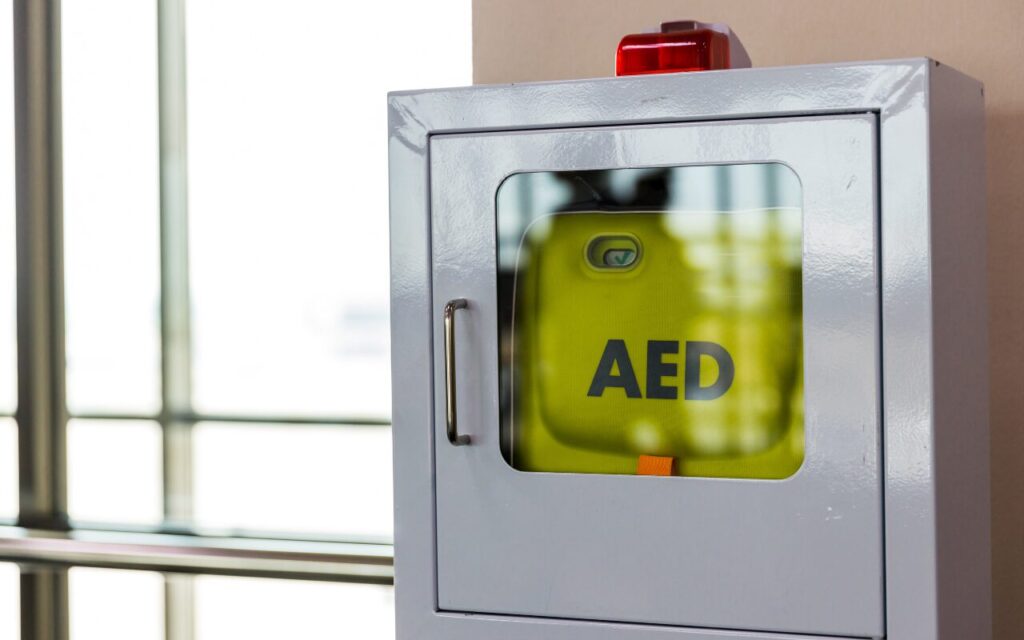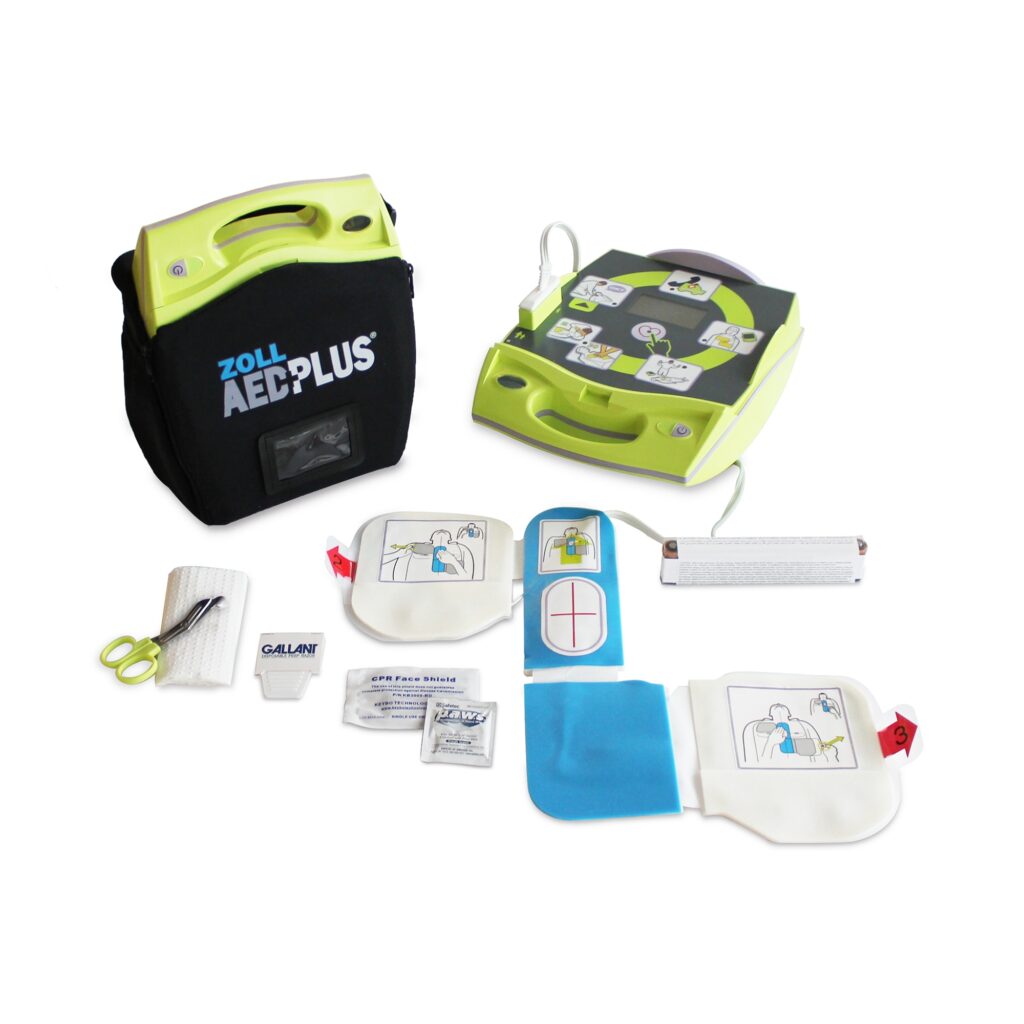Protecting Lives at Work: Importance of AEDs in the Workplace
When it comes to workplace safety, the focus often lies on preventing accidents and maintaining a secure environment. However, one critical aspect we notice being overlooked is being prepared for medical emergencies like sudden cardiac arrest (SCA). Sudden cardiac arrest can occur without warning, and having an Automated External Defibrillator (AED) on-site could be the key to saving a life. This guide explores why you should have AEDs in the workplace, where to position them for maximum effectiveness, the types of AEDs available, and how to ensure they’re always ready for use.

What is an AED?
An Automated External Defibrillator (AED) is a portable medical device designed to treat sudden cardiac arrest (SCA). It works by analyzing the heart’s rhythm and, if necessary, delivering an electrical shock to help the heart re-establish a normal rhythm. AEDs are specifically designed for use by non-medical personnel and provide clear, simple instructions to guide users through the process, making them an invaluable tool in emergencies.
Why Your Workplace Needs an AED
The reality is that sudden cardiac arrest can strike anyone, anywhere, and at any time. In fact, SCA is one of the leading causes of death, and survival rates drop significantly with each passing minute without defibrillation. When an AED is readily available, the chances of survival increase dramatically because of its capability to analyze an arrhythmia and defibrillate it to restore a normal rhythm. EMS response to any pre-hospital setting can vary from 5 to 15 minutes. These are critical moments for a person experiencing SCA to survive by timely recognition, timely CPR and a rapid defibrillation.
In a workplace setting, having an AED is not just about meeting safety regulations; it’s about demonstrating a genuine commitment to the health and well-being of employees and visitors. An AED is a critical tool that can bridge the gap between the onset of SCA and the arrival of emergency medical services, potentially saving a life in the process.
Strategic Placement of AEDs: Location Matters
Having an AED is essential, but where it’s placed is equally important. The goal is to ensure that the device is easily accessible in the event of an emergency, where every second counts. Here are some strategic considerations for placing an AED in your workplace:
- Easy Access for All: Place the AED in a location where it can be accessed by everyone, regardless of where they are in the building. A central location, such as a lobby or main hallway, is often ideal.
- Visibility is Key: The AED should be in a spot where it is easily visible, with clear signage directing people to it. Avoid placing it behind locked doors or in areas that are not frequently accessed.
- Proximity to High-Risk Areas: Consider positioning the AED near areas where there is a higher risk of cardiac events, such as gyms, cafeterias, or areas with heavy machinery.
- Standardized Locations Across Multiple Sites: If your company operates in multiple locations, placing AEDs in similar areas across all sites can ensure that employees know exactly where to find them, regardless of which building they are in.

How to Choose the Right AED
Not all AEDs are the same, and selecting the right one for your workplace requires careful consideration of your specific environment and needs. Here’s a look at the options:
- User-Friendly AEDs: For most workplaces, a simple, easy-to-use AED with clear instructions and visual/audio prompts is sufficient. These are designed for use by non-medical personnel and are ideal for environments where employees may not have advanced medical training.
- Advanced AEDs for Medical Environments: In workplaces with trained medical staff, such as healthcare facilities, you might opt for an AED with more advanced features, including ECG monitoring and the ability to customize shock delivery.
- Portable AEDs: If your employees work across large areas, such as in outdoor settings or on multiple floors, a portable AED that can be easily carried to the site of the emergency is a practical choice.
How to Maintain Your AED
Acquiring an AED is only the first step. To ensure that it is ready to use when needed, regular maintenance and monitoring are crucial. Here’s how you can keep your AED in top condition:
- Routine Checks: Conduct regular inspections to verify that the AED is operational. Check that the battery is charged and that the device shows no signs of damage.
- Replace Expired Components: AEDs have consumable parts, such as batteries and electrode pads, which need to be replaced periodically. Keep a record of expiration dates and ensure replacements are available.
- Update Firmware: Some AEDs require software updates to stay current with the latest resuscitation protocols. Make sure these updates are installed as soon as they become available.
- Employee Training: Regular training sessions on how to use the AED should be conducted for all employees. Consider incorporating AED training into your regular safety drills to ensure that everyone knows how to respond in an emergency.
- AED Management Programs: Professional service providers offer AED Management programs that include regular health checks, replacement of pads and batteries as and when they expire, immediate replacement of pads in the event of a rescue and data download after a rescue.
Final Thoughts
Choosing and maintaining an AED might seem daunting, but it’s a critical investment in your workplace’s safety.
At Medserv Healthcare Solutions, we can help you select the right AED for your environment along with our robust AED Management program supplemented with high quality CPR/AED and First aid training. Whether you need advice on which AED to choose or want to schedule a training session, we’re here to support you. Contact us for a tailored solution for your business or attend a class at one of our training centers.
